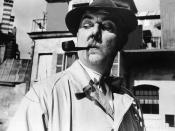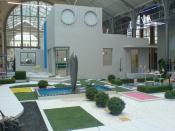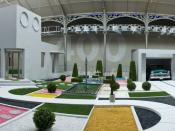In ch.2 of Window Shopping: Cinema and the Postmodern (U of California P, 1993), Anne Friedberg discusses the relationship between the city, modernism, film and architecture. How do her ideas of modernity, particularly her terms 'machines of vision' and 'machines of mobility', relate to 1 or 2 sequences in Tati's Mon Oncle (1958)?
Anne Friedberg's ideas of modernity - including the mobilization of the gaze amidst the modern city, consumerist self-gratification through fetishist agoraphilicism, and the dissolution of distinct psychological boundaries and functions separating public and private spaces, specifically encapsulated in the terms 'machines of vision' and 'machines of mobility' - can be inexorably applied to sequences in Jacque Tati's Mon Oncle, and their interconnectibility can be realized as the epitome of this social machination is observed during the 20 minute sequence of the 'garden party' [54:28-75:00] at the Arpel residence. This leaves us ultimately with the melancholic realization that these 'machines of vision' and 'machines of mobility' which have manifested through the advent of modernization have irrevocably triggered the replacement of the impartial, non-materialistic genuinity of the traditional with the pretentious, consumerist superficiality of the modern.
The 'garden party' sequence begins with a visitor to the Arpel household, as the greengrocer's aged, coughing pickup truck pulls up outside the front gate. We are exposed to an almost proportionately perfectionist shot - where we see a clean, grayscale, modern home occupying the top left of the frame, a dusty, colourful, old pickup truck the bottom right, and a fence the central barrier between them. The contrasting dissonance between the two areas of the frame is symbolic of the differences between modernity and traditionality, and maintains a fascinated gaze from the viewer. As Friedberg discussed, "the tourist simultaneously embodies both a position of presence and absence, or here and elsewhere,



Very Well
Very Well developed essay =D good job.
The only problem i see is how you generalized it too greatly and you did not even seem to have a thesis statement =P
1 out of 1 people found this comment useful.